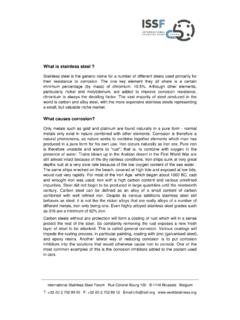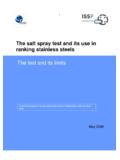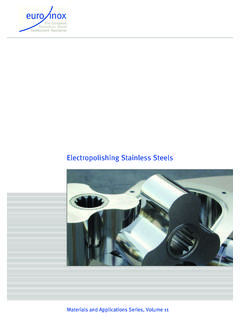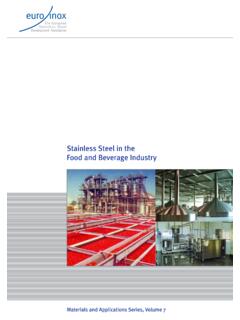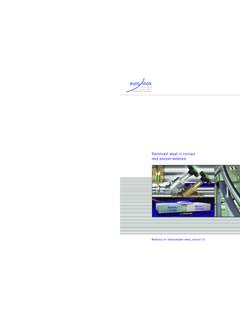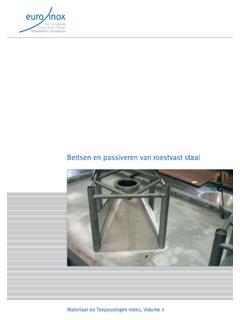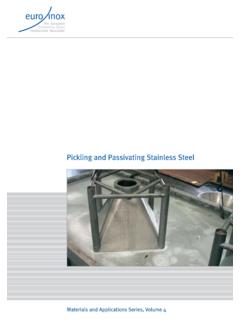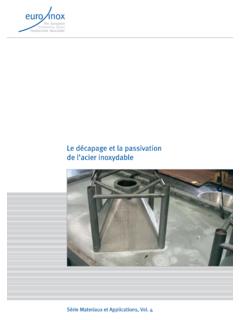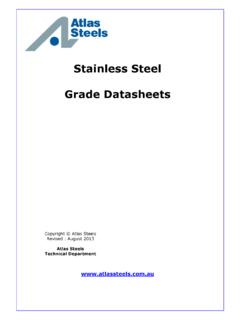Transcription of Pickling and Passivating Stainless Steel
1 Pickling and Passivating Stainless SteelMaterials and Applications Series, Volume 4 Euro InoxEuro Inox is the European market developmentassociation for Stainless Steel . The members of the EuroInox include: European Stainless Steel producers National Stainless Steel development associations Development associations of the alloying elementindustries. The prime objectives of Euro Inox are to create awarenessof the unique properties of Stainless steels and to furthertheir use in existing applications and in new achieve these objectives, Euro Inox organisesconferences and seminars, and issues guidance inprinted and electronic form, to enable designers,specifiers, fabricators and end users to become morefamiliar with the material.
2 Euro Inox also supportstechnical and market research. ISBN 978-2-87997-224-4(First Edition 2004 ISBN 2-87997-047-4)Czech version978-2-87997-139-1 Finnish version2-87997-134-9 French version978-2-87997-261-9 German version978-2-87997-262-6 Dutch version2-87997-131-4 Polish version2-87997-138-1 Spanish version2-87997-133-0 Swedish version2-87997-135-7 Turkish version978-2-87997-225-1 Full Acciai Speciali & ALZ BelgiumUGINE & ALZ FranceArcelor Mittal Stainless Steel Association (BSSA) Edelstahl de D veloppement de l Inox ( ) Chromium Development Association(ICDA) Molybdenum Association (IMOA) Unia Dystrybutor w Stali (PUDS) Euro Inox has made every effort to ensure that theinformation presented in this publication is technicallycorrect.
3 However, the reader is advised that the materialcontained herein is for general information purposesonly. Euro Inox, its members, staff and consultants,specifically disclaim any liability or responsibility forloss, damage or injury, resulting from the use of theinformation contained in this document. Content1. Introduction The Passive Layer22. Comparison of Descaling, Pickling , Passivation and Cleaning33. Pickling Methods5 4. Passivation Treatments75. Welding Heat Tint86. Contamination Rust Staining 107. Specifying Pickling and Passivation12 Pickling and Passivating Stainless SteelSecond Edition 2007(Materials and Applications Series, Volume 4) Euro Inox 2007 Editor Euro InoxHeadquarters: 241 route d Arlon, 1150 LuxemburgGrand Duchy of Luxemburg Tel.
4 : +352 26 10 30 50 Fax: +352 26 10 30 51 Executive office: Diamant Building, Bd. A. Reyers 80 1030 Brussels, Belgium Tel.: +32 2 706 82 67 Fax: +32 2 706 82 69 E-mail: Internet: AuthorsRoger Crookes, Sheffield (UK) Adapted from "Beitsen en passiveren van roestvaststaal by Drs. E. Uittenbroek, Breda (NL) PhotosE. Uittenbroek, Vecom, Maassluis (NL), UGINE & ALZ Belgium , Genk (B), Euro InoxCopyright Notice This work is subject to copyright. Euro Inox reserves allrights of translation in any language, reprinting, re-useof illustrations, recitations and broadcasting. No part ofthis publication may be reproduced, stored in a retrievalsystem, or transmitted in any form or by any means,electronic, mechanical, photocopying, recording orotherwise, without the prior written permission of thecopyright owner, Euro-Inox, Luxemburg.
5 Violations maybe subject to legal proceeding and liable for monetarydamages per infringement as well as cost and legal feesand fall under prosecution act of the Luxemburgcopyright law and regulations within the EuropeanUnion. 1 Pickling AND Passivating Stainless The Passive Layeroccurring conditions such as contact with airor aerated water will create and maintain thecorrosion resisting passive surface this way Stainless steels can keep theircorrosion resistance, even where mechanicaldamage ( scratching or machining) occursand so have an in-builtself-repairing corrosionprotection system. The chromium in Stainless steels is primarilyresponsible for the self-passivation contrast to carbon or low alloy steels, Stainless steels must have a minimumchromium content of (by weight) ofchromium (and a maximum of carbon ).
6 This is the definition of Stainless steels givenin EN 10088-1. The corrosion resistance ofthese chromium-steels can be enhanced withaddition of other alloying elements such asnickel, molybdenum, nitrogenand titanium(or niobium). This provides a range of steelswith corrosion resistances over a wide rangeof service conditions as well as enhancingother useful properties such as formability,strength and heat (fire) resistance. Stainless steels cannot be consideredcorrosion resistant under all service on the type (composition) of thesteel there will be certain conditions where thepassive state is broken down and preventedfrom reforming. Here the surface becomes'active', resulting in corrosion. On stainlesssteels active conditions can occur in small areasdeprived of oxygen, such as at mechanicaljoints,tight corners or at incomplete or poorlyfinished welds.
7 The result can be 'localised'forms of crevice or pitting corrosion resistance of Stainless Steel isdue to a 'passive', chromium-rich complex,oxide film that forms naturally on the surfaceof the Steel . This is the normal condition forstainless Steel surfaces and is known as the'passive state' or 'passive condition'. Stainless steels will naturally self-passivatewhenever a clean surface is exposed to anenvironment that can provide enough oxygento form the chromium-rich oxide surface occurs automatically and instantaneously,provided there is sufficient oxygen availableat the surface of the Steel . The passive layerdoes however increase in thickness for sometime after its initial formation. NaturallyStainless Steel surfaces have a unique self-healingsurface protection system.
8 The transparent passivelayer quickly reforms if damaged, provided there issufficient oxygen in the surroundings. Surfacecoatings or corrosion protection systems are notnormally needed for Stainless steels to perform asnaturally corrosion resistant Steel surfaces form a grey/black scaleduring hot rolling or forming. This tenacious oxidescale is removed in the steelmill by matt grey is left on annealed mill products followingdescaling and Pickling . Mechanical scale looseningroughens the terms 'descaling', ' Pickling ' and 'passivation'are often confused, but are distinct is important to be clear about the differencesbetween these surface treatment processesas applied to Stainless steels. Descaling Descaling is the removal of a thick visibleoxide scale from the surface.
9 This oxide isusually dark grey. This process is doneroutinely in the manufacturing Steel millbefore the Steel is delivered. Mill descaling is usually a two-stage process, one tomechanically loosen the 'mill-scale', thesecond to lift the loosened scale clear from themetal surface. The exposed metal surface isthen usually pickled to remove the metal layerthat was immediately beneath the scale. Thisstage of the process should be consideredas a separate one, some slight scaling may occur inthe high temperature heat affected zone ofwelds or during high temperature heat treatmentprocesses on fabricated Stainless Steel parts,further descaling operations are not usuallynecessary. Pickling Pickling is the removal of a thin layer of metalfrom the surface of the Stainless of nitric and hydrofluoric acids areusually used for Pickling Stainless is the process used to remove weldheat tinted layers from the surface of stainlesssteel fabrications, where the Steel s surfacechromium level has been AND Passivating Stainless STEEL2.
10 Comparison of Descaling, Pickling ,Passivation and Cleaning Acid treatments alone cannot be relied uponto remove oil, grease or inorganic contaminantsthat can also prevent the passive layer formingproperly. Combinations of degreasing, cleaning, Pickling and passivation treatments may benecessary to fully prepare machined or fabricatedstainless Steel surfaces for their intendedservice conditions. If Stainless parts are contaminated with greaseor oil, then a cleaning operation prior to acidtreatment should be carried out. Pickling AND Passivating Stainless STEELL ight scaling left on weldcaps and heat tint on the surrounding parenttube surfaces canusually be removed byacid , uneven pickledsurfaces can result ifsurfaces are not clean beforethe acid PassivationPassivation usually occurs naturally on thesurfaces of Stainless steels, but it maysometimes be necessary to assist the processwith oxidising acid treatments.
